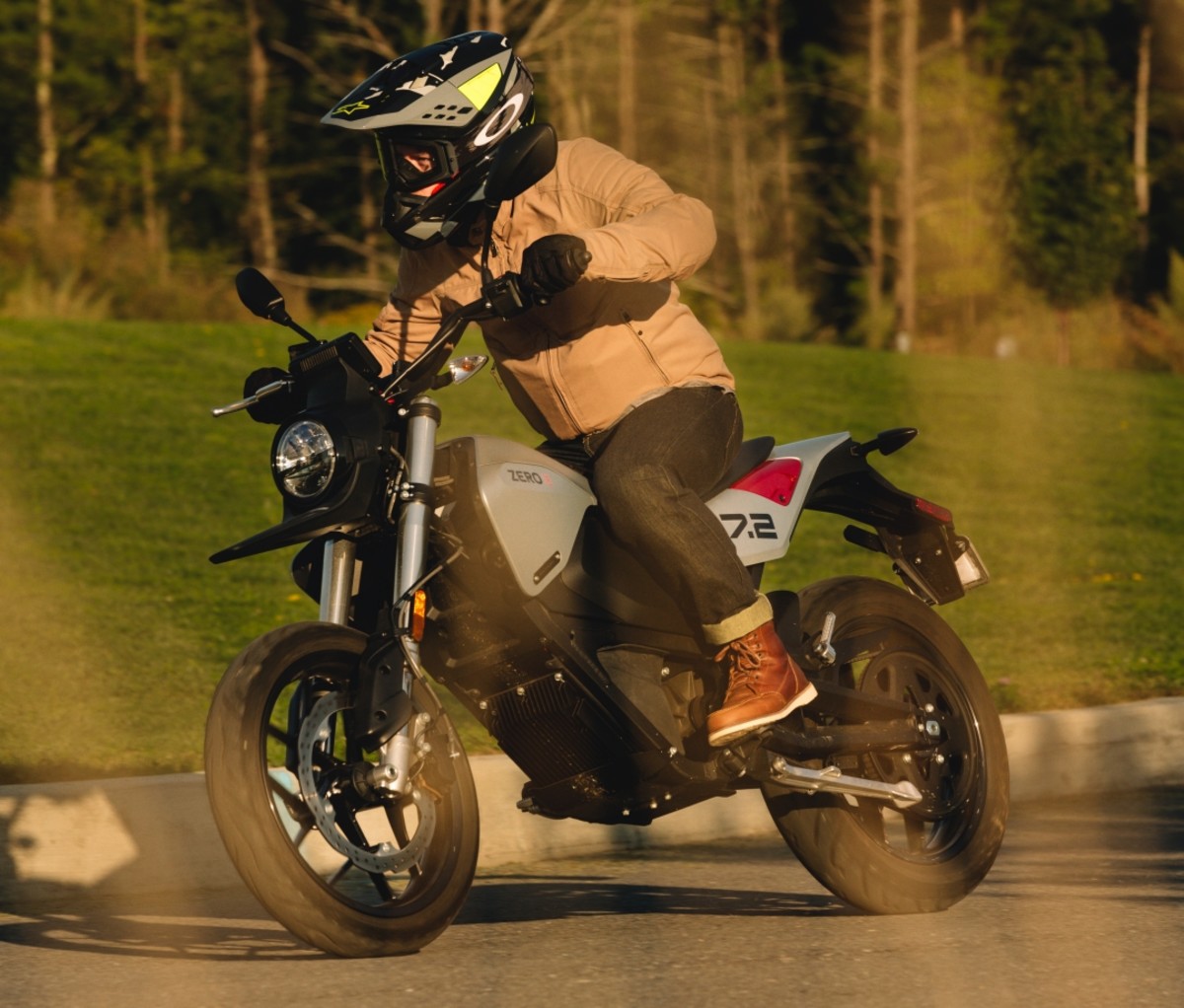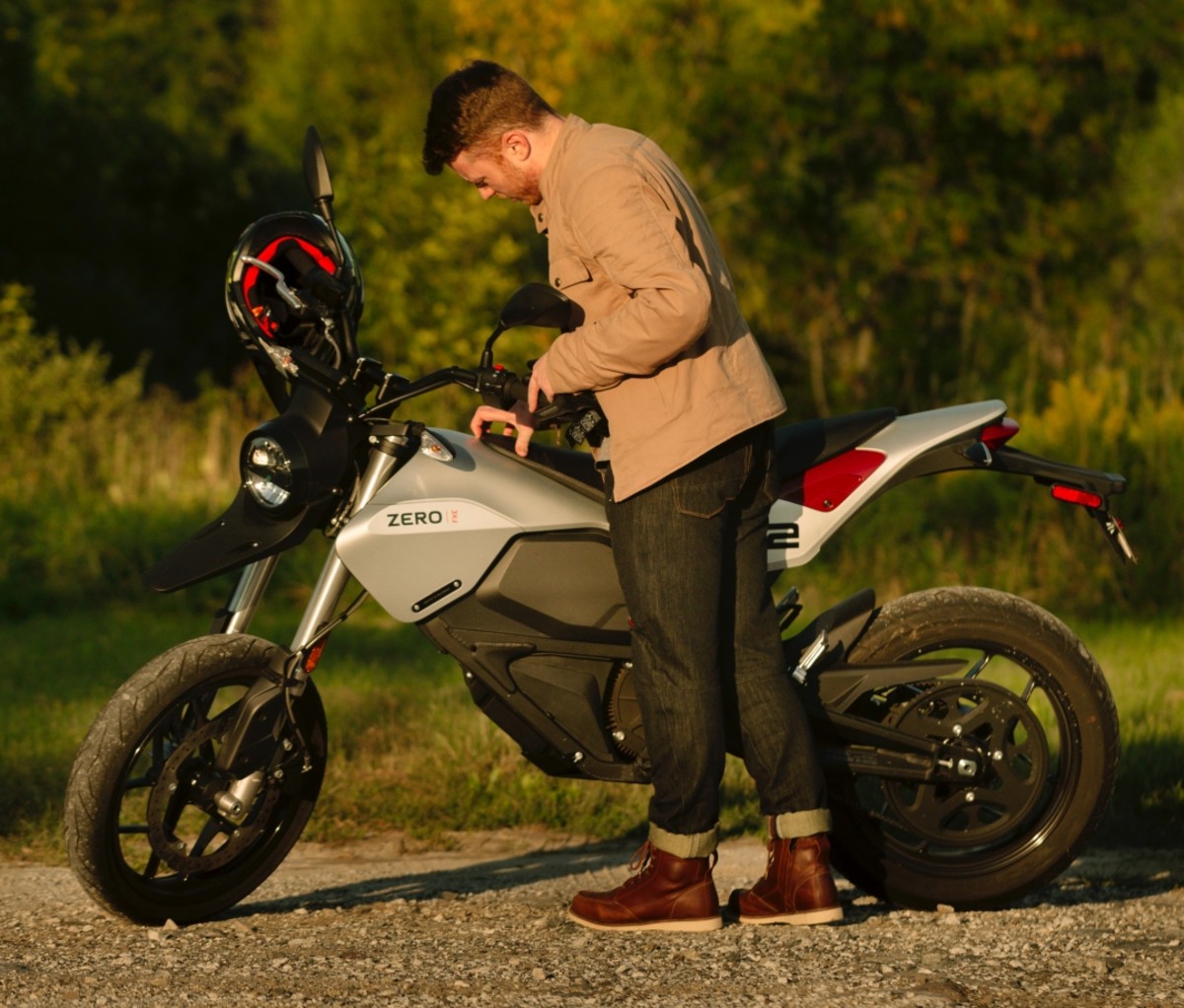Learning to Ride on a Zero FXE Electric Motorcycle

Getting a motorcycle license has long been a goal of mine. It always seemed like a natural extension of my absolute obsession with life on two wheels. I’m a self-proclaimed accomplished cyclist, so how hard could it be to transition from pedal power to motor power?
“Not hard,” I was assured by friends who’ve ridden motorcycles their whole lives—and who played more than a small role in egging me on.
I was confident in my ability to handle the bike once I got it going—22 years of riding mountain bikes and six years on road bikes had me certain. The biggest hurdle standing in my way was the clutch. I never learned to drive a stickshift. The intimidation factor of combining a hand-operated clutch, a foot-operated shift lever, and learning how to handle an entirely new-to-me mode of transportation was enough to give me pause in chasing my goal.
But what if there wasn’t a clutch? What if there was no shifting? And what if there was hardly any maintenance? That would certainly change my mind. And it did when I learned about the Zero Motorcycles FXE.
For the unfamiliar, Zero is a California-based company making some of the best electric motorcycles available. Thanks to its electric powertrain, the FXE has no clutch, no shift lever, no neutral—to ride it, you just turn it on and hit the throttle. When you return home, you plug it into a standard outlet to charge the battery. It’s about as approachable as a motorcycle gets.
In my mind, the electric powertrain significantly lowered the barrier to entry. And when Zero offered me an FXE to test, that left only a 25-question written exam and a live skills test standing between me and cruising ribbons of twisting pavement through Vermont hillsides. The FXE left me with virtually no excuse not to check the box of getting my moto license.

The Bike
In terms of electric motorcycles, the Zero FXE is far and away the most approachable and most accessible. Competitors include more intense bikes from the likes of Energica and Damon, the latter of which will reach 200 mph—hardly suitable for a newbie. There are also a few less-polished offerings from Kollter, among others. They’re affordable, but they lack the polished presentation of the Zero. The FXE strikes a great balance between performance, refinement, approachability, and affordability. In other words, it’s a perfect battery-powered beginner bike.
That said, there are some downsides. Electric bikes are notoriously expensive when compared to gas ones, and the Zero FXE certainly isn’t immune to this criticism. The bike will set you back $12,995 without the quick charger. By comparison, a new Honda CB300R comes in at $4,949 MSRP. That’s a tough pill to swallow.
But consider the savings. When it comes to maintenance, the bike requires no oil changes, and there’s no chain to keep lubricated or replace when it becomes worn. Plus you’ll save on gas (especially considering current pricing), and there are often incentives available for purchasing EVs (more on that below). Once you factor all that in, buying an electric motorcycle starts to look a whole lot better, financially speaking.
The Gear
Before I ventured out on the road, I wanted to make sure I was properly outfitted. I didn’t compromise when it came to safety equipment. I went with a full kit from Alpinestars, including the SM5 Rover Helmet, Oscar Monty V2 boots, Victory Tech Denim pants, Crossland gloves and a full Tech-Air 5 wearable airbag system (the most advanced wearable safety system available for motorcycles). Add in top-tier eye protection in the form of Oakley’s Front Line MX goggles, and I was more than ready to hit the road.

The Nuts and Bolts: What Do You Actually Need to Do?
First, a major caveat: My experience applies to the state of Vermont. And while many states are similar, this is by no means an exhaustive guide to getting your motorcycle license in any state.
In Vermont, the process of getting your motorcycle license is pretty simple. Step one is studying the handbook. This outlines not only laws for operating a motorcycle, but also tons of tips and information to make sure you’re safe on two wheels. While many of them are only applicable to gas-powered bikes, there are plenty of tips that apply to electric bikes, too.
I studied this book for hours. I memorized which of the “three lanes” within a lane of travel is safest. I drilled into my brain the notion that no driver will ever see me, even if I make eye contact. And so on. Then I took my written exam online—and received the instant gratification of a passing grade. That afforded me 120 days of practice riding during the day with no passengers, and only in the state of Vermont.
The other option for those seeking their license is to take the Motorcycle Safety Foundation course. This course will teach you to ride a gas-powered bike, and it will walk you through everything you need to know to ace the written test and get your license.
Since riding gas-powered motorcycles didn’t interest me, I skipped the MSF course. Even so, I would absolutely benefit from taking the course and may still do so in the future. But for the sake of achieving my goal of getting my license, and doing it by riding an electric motorcycle, I felt confident with my solo studying and real-world practice.
Step two on the licensing journey is to make sure that you have a properly insured and registered motorcycle to take the skills test. Since I was using a loaner Zero FXE, that part was already taken care of for me.

Riding the Zero FXE
My first impression of the FXE when I got it out on the road? It is quick. The best comparison I can make is to a handful of e-bikes I’ve ridden over the years. But the boost of torque you get with a pedal-assist e-bike is nothing compared to a twist of the throttle on the FXE. It’s instant power.
The actual mechanics of turning, braking, and navigating roadways, however, felt as intuitive as riding my road bike. It takes a bit more muscle considering the FXE weighs 300 pounds, but riding it felt totally manageable.
The FXE is also nearly silent. In that way, it’s similar to riding a road bike down a long hill—and much quieter than even a small gas-powered motorcycle. You mostly hear road noise, a bit of mechanical whirring, and the rubber on the road surface. The electric motor paired with a belt drive means that mechanical noise generated by the bike is kept to a minimum. Most gas-powered bikes feature traditional chain drives, which are notably louder than belt drives and require more maintenance.
In terms of weight, the Zero FXE (298 pounds) compares favorably with the aforementioned Honda CB300R ABS (317 pounds).
While I had the bike, I used it most often on the 18-minute commute from my house to the office. It’s a prime use case for the FXE. No highways or high-speed roads, just standard streets with traffic lights and stops signs through neighborhoods and downtown Burlington, VT. There’s plenty of range to go out and have some fun on the back roads (I got about 78 miles to a charge in real-world testing), but I was cautious given my beginner status.
In terms of charging, keeping the FXE topped up couldn’t have been simpler. It plugs right into a standard household outlet. That made it easy to ensure I always had a full charge before heading out. The downside is that you can’t charge it at the burgeoning network of EV charging stations, though there are other Zero models that offer that capability.

The Test
After a few weeks of getting comfortable on the bike, it was time to schedule my Motorcycle Skills Test. Vermont, along with many states in the U.S., uses a standardized motorcycle skills test referred to as the ALT MOST test. It consists of four exercises—a cone weave, a right turn and sweeping u-turn, a quick stop, and an obstacle swerve. All of the exercises are completed at low speeds (around 12 to 18 mph), which actually makes the test somewhat difficult, and even harder to pass on bigger and more powerful bikes.
When I showed up at my test, the FXE garnered the most attention—which is saying a lot considering the other two riders were on a Ducati Panigale and a Suzuki GSX R.
“Is that electric?”
“What do you think of it?”
“Is it fast?”
The questions kept coming. Even the test administrator quipped “cool bike” when he glanced over to inspect my plate and registration. Luckily, all of the questions were quick and easy to answer over the rumble of their gas-powered engines and through the grip of my heightened nerves.
“Yes.”
“It’s awesome.”
“Sure is.”
I moved through all four exercises smoothly and quickly. No line touches, no cone hits, and no feet down. The Zero’s lack of a clutch, instant power, and eco mode throttle map, along with its centered and fairly upright riding position, made the slow maneuvers stress-free and intuitive.
I circled back to the small brick building at the testing site, paid the nominal fee to add the motorcycle endorsement to my license, and became the state of Vermont’s newest licensed motorcycle rider.
So You Want An Electric Motorcycle of Your Own? Check Out the Tax Credits
Despite the federal government rolling back and revising many of the EV tax credits, there are still plenty of ways to save on the purchase of an electric motorcycle.
The first place to look is with your state government. Many state governments offer incentives for EVs, and while not all states offer these credits for electric motorcycles, a handful do. Zero even has a portal that tracks available state incentives.
A lesser-known way of earning some money back on an electric motorcycle purchase is through your utility provider. Many utilities offer kickbacks for purchases of electric motorcycles. For instance, my utility is currently offering $500 in statement credits for the purchase of an electric motorcycle. Some utilities will even install free Level 2 chargers for owners of EVs, motorcycles included.

The Takeaways
Getting my motorcycle license afforded me a freedom that I hadn’t experienced in other two-wheeled modes of transportation, and Zero’s FXE made that possible. It’s obviously faster than pedaling a bike, but it offers a similar wind-in-your-face, open-air feeling that’s understandably addicting. It lacks the sweat and grit of cycling, but it also lacks the sweat and grit of cycling. I can’t say for certain whether or not I would have pursued it if electric motorcycles didn’t exist, but I can say unequivocally that choosing a battery-powered motorcycle made it easier and more attainable for me.
If you’re in the same boat, consider an electric motorcycle, and particularly the FXE. It’s a hyper-fun commuter that offers plenty of power without overdoing it, and it’s right in the sweet spot for a beginner.
Check out our Zero FXE inventory here
